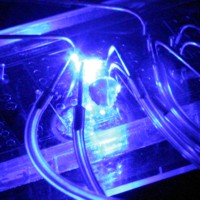News
Profile of Scott Diamond in Penn Engineering, Spring 2013
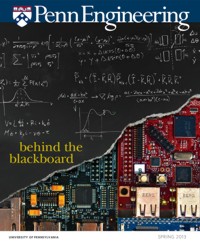 |
"Diamond uses liquid-handling robots, originally developed for the pharmaceutical industry, to run thousands of measurements on a small volume of an individual's blood. "Each person's blood has a unique personality, a phenotype, in the way it responds to all the many different stimuli present during a clotting event," Diamond says. His team uses these data sets to train computer models to predict the severity of a heart attack given one's blood profile. These computer simulations help identify the patient-specific benefits or risks of a particular drug therapy."
Read the entire article online here, or download a PDF of the entire issue of Penn Engineering. |
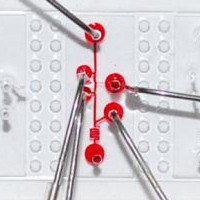 |
Science News reports on research (Nov 2012)
conducted at the Diamond lab by Ryan Muthard and Scott Diamond, showing that clots forming under arterial-flow conditions have an unexpected ability to sense the surrounding blood moving over it.If the flow stops, the clot senses the decrease in flow and this triggers a contraction similar to that of a muscle. The contraction squeezes out water, making the clot denser.
Better understanding of the clotting dynamics that occur in atherosclerosis, as opposed to the dynamics at play in closing a wound, could lead to more effective drugs for heart-attack prevention. |
 |
Science News reports on research (May 2012) conducted at the Diamond Lab by Scott Diamond and Talid Sinno, with Matthew Flamm, Tom Colace and Manash Chatterjee. The team developed multi-scale models of blood flow to predict how platelets responded to blood vessel damage under the influence of a variety of anti-coagulation drugs. This enables the development of personalized "virtual blood" computer models that can predict the effectiveness of anticoagulation drugs for particular patients. |
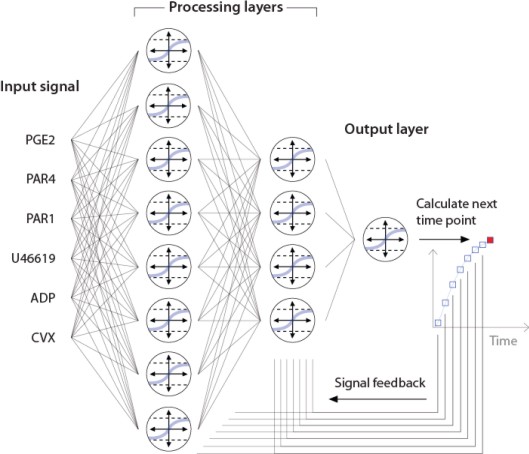 |
Science News reports that Researchers Manash Chatterjee and Scott Diamond of the Diamond Lab, working with Jeremy E. Purvis of the Department of Genomics and Computational Biology and Lawrence F. Brass of the Department of Medicine at Penn, have trained a computer neural network model to accurately predict how blood platelets would respond to complex conditions found during a heart attack or stroke. The research team developed its experimental/computational technique, called Pairwise Agonist Scanning, or PAS, to define platelet response to combinations of agonists, chemicals that bind in this case to platelet cells, initiating a cellular response. The online article is here. |
Systems Biology Symposium
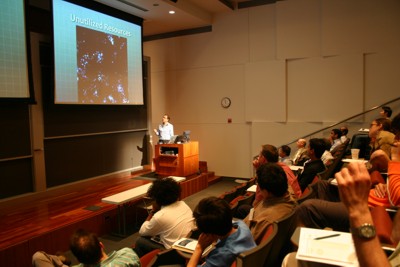 |
The Diamond Lab hosted a Systems Biology Symposium on June 23-24, 2009, in the Wu and Chen Auditorium at Levine Hall and the Computing Labs of the Moore Building. You can read the Program Booklet, and see photos of the event, on our page for the Symposium. |
 Kinetic Characterization and Molecular Docking of a Novel, Potent, and Selective Slow-Binding Inhibitor of Human Cathepsin L Kinetic Characterization and Molecular Docking of a Novel, Potent, and Selective Slow-Binding Inhibitor of Human Cathepsin L
Parag P. Shah, Michael C. Myers, Mary Pat Beavers, Jeremy E. Purvis, Huiyan Jing, Heather J. Grieser, Elizabeth R. Sharlow, Andrew D. Napper, Donna M. Huryn, Barry S. Cooperman, Amos B. Smith, III, and Scott L. Diamond
Mol Pharmacol 2008 74: 34-41. Published online April 10, 2008
[Abstract] [Full Text] [PDF]
The University of Pennsylvania was awarded a $2.8 million grant as one of three national centers for Systems Biology by the National Heart, Lung, and Blood Institute of the NIH.
The three-year project will focus on “Blood Systems Biology” and is headed by Dr. Scott L. Diamond, Arthur E. Humphrey Professor of Chemical and Biomolecular Engineering and Bioengineering; Associate Director and Charter Member, Institute for Medicine and Engineering; Director, Biotechnology Program; and Director, Penn Center for Molecular Discovery.
The Cluster Team will deploy integrative and hierarchical computational models and experimental studies to predict spatial-temporal processes in mouse and human blood under hemodynamic conditions. An interdisciplinary team of faculty from the School of Engineering and Applied Sciences includes Drs. Daniel Hammer (bioengineering), Talid Sinno (chemical and biomolecular engineering) and George Biros (mechanical engineering and applied mechanics) along with Dr. Skip Brass (medicine and pharmacology) and Dr. Mark Kahn (cardiovascular medicine) from the School of Medicine. The team has expertise in experimental and computational hemodynamics, platelet biology, coagulation and protease biochemistry, continuum/stochastic simulation, robotic automation, and knockout mice for thrombosis research.
“Blood is ideal for Systems Biology research since it is easily obtained from donors or patients, amenable to high throughput liquid handling experiments, and clinically relevant,” said Dr. Diamond. “Better elucidation and quantitative simulation of blood reactions and platelet signaling pathways under hemodynamic conditions are directed at clinical needs in thrombosis risk assessment, anti-coagulation therapy, platelet targeted therapies, and stroke research,” he added.
$9.5 Million from NIH for Penn Center for Molecular Discovery
The University of Pennsylvania is receiving $9.5 million from the National Institutes of Health during the next three years to establish the Penn Center for Molecular Discovery. The Penn team will screen the NIH repository of compounds to discover new biological interactions. [read full story...]
|
